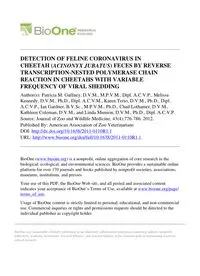
2012 DETECTION OF FELINE CORONAVIRUS IN CHEETAH (_ _i_ACINONYX JUBATUS__i__ ) FECES BY REVERSE PDF
Preview 2012 DETECTION OF FELINE CORONAVIRUS IN CHEETAH (_ _i_ACINONYX JUBATUS__i__ ) FECES BY REVERSE
BioOne sees sustainable scholarly publishing as an inherently collaborative enterprise connecting authors, nonprofit publishers, academic institutions, research libraries, and research funders in the common goal of maximizing access to critical research. DETECTION OF FELINE CORONAVIRUS IN CHEETAH (ACINONYX JUBATUS) FECES BY REVERSE TRANSCRIPTION-NESTED POLYMERASE CHAIN REACTION IN CHEETAHS WITH VARIABLE FREQUENCY OF VIRAL SHEDDING Author(s): Patricia M. Gaffney, D.V.M., M.P.V.M., Dipl. A.C.V.P., Melissa Kennedy, D.V.M., Ph.D., Dipl. A.C.V.M., Karen Terio, D.V.M., Ph.D., Dipl. A.C.V.P., Ian Gardner, B.V.Sc., M.P.V.M., Ph.D., Chad Lothamer, D.V.M., Kathleen Coleman, D.V.M., and Linda Munson, D.V.M., Ph.D., Dipl. A.C.V.P. Source: Journal of Zoo and Wildlife Medicine, 43(4):776-786. 2012. Published By: American Association of Zoo Veterinarians DOI: http://dx.doi.org/10.1638/2011-0110R1.1 URL: http://www.bioone.org/doi/full/10.1638/2011-0110R1.1 BioOne (www.bioone.org) is a nonprofit, online aggregation of core research in the biological, ecological, and environmental sciences. BioOne provides a sustainable online platform for over 170 journals and books published by nonprofit societies, associations, museums, institutions, and presses. Your use of this PDF, the BioOne Web site, and all posted and associated content indicates your acceptance of BioOne’s Terms of Use, available at www.bioone.org/page/ terms_of_use. Usage of BioOne content is strictly limited to personal, educational, and non-commercial use. Commercial inquiries or rights and permissions requests should be directed to the individual publisher as copyright holder. Journal of Zoo and Wildlife Medicine 43(4): 776–786, 2012 Copyright 2012 by American Association of Zoo Veterinarians DETECTION OF FELINE CORONAVIRUS IN CHEETAH (ACINONYX JUBATUS) FECES BY REVERSE TRANSCRIPTION-NESTED POLYMERASE CHAIN REACTION IN CHEETAHS WITH VARIABLE FREQUENCY OF VIRAL SHEDDING Patricia M. Gaffney, D.V.M., M.P.V.M., Dipl. A.C.V.P., Melissa Kennedy, D.V.M., Ph.D., Dipl. A.C.V.M., Karen Terio, D.V.M., Ph.D., Dipl. A.C.V.P., Ian Gardner, B.V.Sc., M.P.V.M., Ph.D., Chad Lothamer, D.V.M., Kathleen Coleman, D.V.M., and Linda Munson, D.V.M., Ph.D., Dipl. A.C.V.P. Abstract: Cheetahs (Acinonyx jubatus) are a highly threatened species because of habitat loss, human conflict, and high prevalence of disease in captivity. An epidemic of feline infectious peritonitis and concern for spread of infectious disease resulted in decreased movement of cheetahs between U.S. zoological facilities for managed captive breeding. Identifying the true feline coronavirus (FCoV) infection status of cheetahs is challenging because of inconsistent correlation between seropositivity and fecal viral shedding. Because the pattern of fecal shedding of FCoV is unknown in cheetahs, this study aimed to assess the frequency of detectable fecal viral shedding in a 30-day period and to determine the most efficient fecal sampling strategy to identify cheetahs shedding FCoV. Fecal samples were collected from 16 cheetahs housed at seven zoological facilities for 30 to 46 consecutive days; the samples were evaluated for the presence of FCoV by reverse transcription-nested polymerase chain reaction (RT-nPCR). Forty-four percent (7/16) of cheetahs had detectable FCoV in feces, and the proportion of positive samples for individual animals ranged from 13 to 93%. Cheetahs shed virus persistently, intermittently, or rarely over 30–46 days. Fecal RT-nPCR results were used to calculate the probability of correctly identifying a cheetah known to shed virus given multiple hypothetical fecal collection schedules. The most efficient hypothetical fecal sample collection schedule was evaluation of five individual consecutive fecal samples, resulting in a 90% probability of identifying a known shedder. Demographic and management risk factors were not significantly associated (P � 0.05) with fecal viral shedding. Because some cheetahs shed virus intermittently to rarely, fecal sampling schedules meant to identify all known shedders would be impractical with current tests and eradication of virus from the population unreasonable. Managing the captive population as endemically infected with FCoV may be a more feasible approach. Key words: Acinonyx jubatus, cheetah, feces, feline coronavirus, feline infectious peritonitis virus, reverse transcription-nested polymerase chain reaction, shedding. INTRODUCTION Cheetahs (Acinonyx jubatus) are globally endan- gered, and the African subspecies is listed as vulnerable by the International Union for Con- servation of Nature and as threatened by the Convention on the International Trade in Endan- gered Species-Appendix I.4 Estimates of the number of cheetahs remaining in the wild range from 10,000 to 12,000 in Africa, with the majority in Namibia. The wild population is threatened because of habitat loss, poaching, and conflicts with humans.23,24 To combat decline in numbers and enhance genetic diversity, reproduction of the captive cheetah population in the United States is intensively managed by the American Zoo and Aquarium Association (AZA) Cheetah Species Survival Plan (SSP). Management practices in- clude cohousing and movement of animals be- tween zoological facilities for breeding, practices that also provide opportunity for disease trans- mission. Despite concerted efforts, the captive cheetah population is not self-sustaining.22 In the AZA Cheetah SSP population, deaths outnumber births because of poor fertility and a high prevalence of diseases, such as chronic gastritis associated with Helicobacter sp., amyloidosis, glomerulosclerosis, and veno-occlusive dis- ease.21,27,41 Cheetahs are also susceptible to infec- tion with feline coronavirus (FCoV), and infection From the Departments of Pathology, Microbiology, and Immunology (Gaffney, Terio, Munson) and Medicine and Epidemiology (Gardner), School of Veterinary Medicine, University of California, Davis, California 95616, USA; and the Department of Comparative Medicine, College of Veterinary Medicine, University of Tennessee, Knoxville, Tennessee 37996, USA (Kennedy, Lothamer, Coleman). Present addresses (Terio): Zoological Pathology Program, University of Illinois, Maywood, Illinois 60153, USA; (Gardner): Department of Health Management, Atlantic Veterinary College, University of Prince Edward Island, Charlottetown, Prince Edward Island C1A 4P3, Canada. Correspondence should be directed to Dr. Gaffney (
